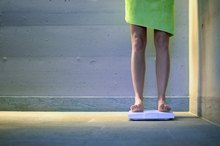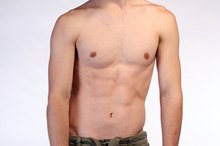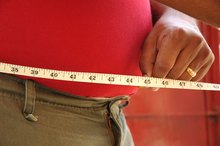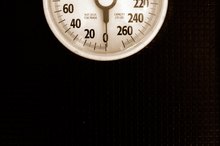How to Calculate Body Fat Using Waist Measurement & Weight
While your waist measurement and weight can help you estimate whether you're at a healthy size -- and whether or not you're at a higher risk of weight-related illness -- they aren't the best way to figure out your body fat levels. To get an accurate measurement of your body fat, you'll have to consult a professional. If you're overweight with a large waist circumference, focus on getting into a healthy weight range first -- then invest in clinical tests to track your body fat percentage.
Estimating Body Fat Using the DoD Method
If you're looking for a relatively easy estimate, try the Department of Defense's method for estimating body fat. It uses your height and your waist circumference minus your neck circumference if you're a man; if you're a women, it estimates body fat based on your waist circumference, hip circumference, neck circumference and height.
While you could work it out yourself, the equation is a bit complicated, so luckily you can use tables with the values calculated out for you. (ref 1 p13) Using this method, a 5-foot, 9-inch tall man with a waist circumference 19 inches larger than his neck circumference has a body fat percentage of about 18 percent. (ref 1 p20) A 5-foot-5-inch woman whose waist plus hip circumference minus her neck circumference equals 55 has a body fat percentage of about 29 percent. (ref 1 p30)
Estimating Lean Body Mass
How Does a Scale Measure Body Fat?
Learn More
An online lean body mass calculator can help you estimate how much of your weight consists of muscle and lean tissue. Whatever weight remains consists of body fat. This calculation uses age, gender, height and weight rather than your waist circumference and weight. In most people, lean body mass consists of between 60 and 90 percent of weight. (ref 2) The equations used to estimate lean body mass are relatively accurate, but can overestimate lean body mass by a few pounds, according to a study published in BMC Pharmacology & Toxicology in 2013. (res 1)
For example, using this type of calculator, a 5-foot, 3-inch tall, 40-year-old woman who weighs 150 pounds has about 96.4 to 101.5 pounds of lean body mass, depending on the equation used by the calculator. (ref 2) Subtract the lean body mass from the total weight to figure out how many pounds of fat you have, then divide the pounds of body fat by your total weight to get your body fat percentage. In this example, the woman has about 48.5 to 53.6 pounds of fat, which is 32 to 35 percent of her weight.
Waist Circumference and Body Fat
Your overall body fat isn't the only thing that's important, it also makes a difference where you carry your weight. Having a large waist circumference can indicate that you have a lot of a dangerous type of fat called visceral fat, which surrounds your organs. If you're a woman, your waist shouldn't measure more than 35 inches, and, if you're a man, it should be less than 40 inches to limit your risk for heart disease and diabetes. (ref 3)
Waist-to-hip ratio and waist-to-height ratio can help determine if you've got too much belly fat as well. Your waist circumference divided by your hip circumference, or WHR, shouldn't be more than 0.8 for good health. (ref 4) Women should have a waist-to-height ratio, or WHtR, of between 0.42 and 0.48, and men should have one between 0.43 and 0.52. You can calculate WHtR by dividing your waist circumference in inches by your height in inches. (ref 5 & 6 if 5 isn't working) For example, a 5-foot, 2-inch tall woman should have a waist measuring between 27 and 30 inches, and a 6-foot tall man should have one measuring from 31 to 38 inches. (ref 6)
Methods for Measuring Body Fat
Normal Weight for a 5'4" Girl
Learn More
Even if you're at a healthy weight, you might carry too much body fat. This condition, called normal weight obesity, puts you at the same risk of obesity-related illnesses as being overweight. (ref 7) Your doctor can order an MRI or CT scan or underwater weighing, which measure body fat more accurately, if there's a concern about your body composition. A person trained to use skin calipers or handheld scanners that use bioelectrical impedance analysis, or BIA, can also measure your body fat. Fat slows down the painless electrical signal passed through your body by BIA scanners, so the longer it takes the signal reach the other side of your body, the more fat you have. (ref 10)
Related Articles
References
- Calculator.net: Lean Body Mass Calculator
- National Heart, Lung, and Blood Institute: Assessing Your Weight and Health Risk
- University of Nevada Cooperative Extension: Weighing In On Body Fat
- ShapeFit.com: Waist To Height Ratio Calculator – Assess Your Lifestyle Risk
- European Heart Journal: Normal Weight Obesity: A Risk Factor for Cardiometabolic Dysregulation and Cardiovascular Mortality
- Centers for Disease Control and Prevention: About Adult BMI
- American Cancer Society: Normal Weight Ranges: Body Mass Index (BMI)
- CNN: Which Test Should I Trust When Measuring My Body Fat?
Resources
Writer Bio
Michelle Devine is a health and wellness educator in California. Her areas of interest and experience include nutrition, exercise and behavior modification. She has written numerous health articles for various online publications. Devine holds a Bachelor of Arts in psychology and is also an NASM-certified personal trainer.








